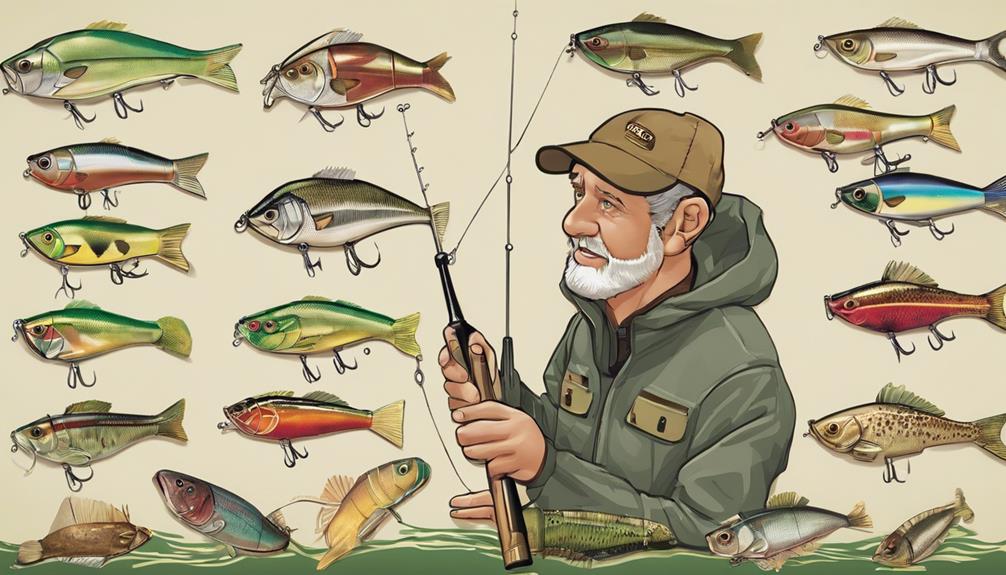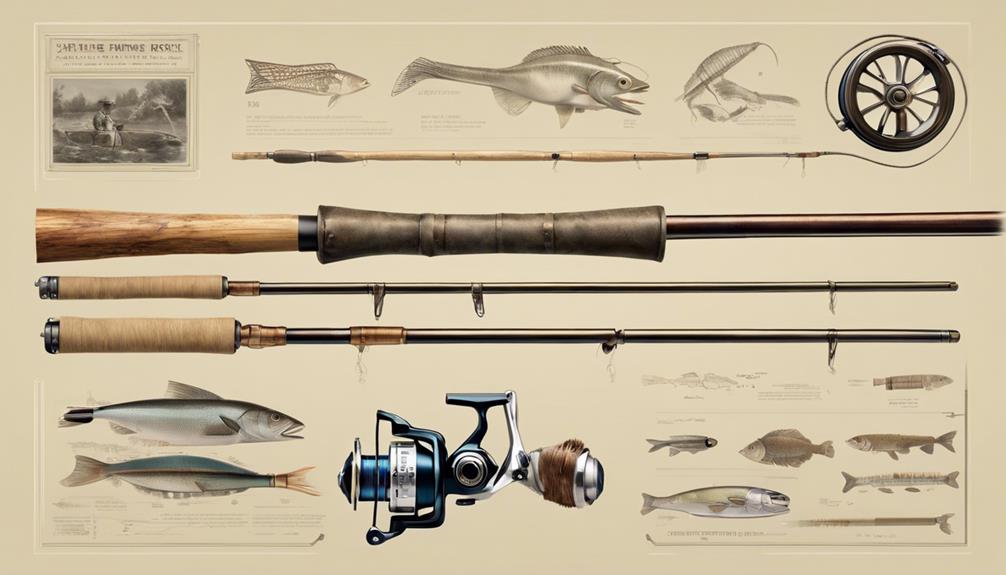Did you know that the earliest known fishing hook dates back to about 42,000 years ago?
Imagine the journey angling technology has taken since then.
From simple hooks crafted out of bone to intricate electronic innovations that can locate fish underwater, each era has left its mark on the tools and techniques anglers use.
As you explore the historical innovations that have shaped angling technology, you'll uncover a fascinating evolution that mirrors humanity's quest to enhance the art of fishing.
Early Fishing Implements
Exploring the history of angling technology reveals how early fishing implements revolutionized the way humans interacted with water environments. In ancient times, primitive tools and ancient techniques were instrumental in the development of fishing as a means of sustenance and recreation. The first fishing implements were simple and rudimentary, consisting of sharpened sticks or bone hooks used to catch fish in rivers, lakes, and oceans.
Early anglers employed various innovative methods to enhance their fishing capabilities. One of the most significant advancements was the creation of fishing nets, which allowed for the capture of larger quantities of fish with greater efficiency. These nets were woven from natural fibers such as plant materials or animal sinew, showcasing early humans' resourcefulness in utilizing materials from their surroundings to improve their fishing practices.
Furthermore, the invention of fishing lines marked a pivotal moment in angling technology. Initially crafted from plant fibers or animal hair, these lines were attached to hooks made from bone or metal. Anglers also began using floats made from natural materials like cork or wood to keep their bait at the desired depth in the water, showcasing a sophisticated understanding of fish behavior and habitat.
Introduction of Reels
The introduction of reels revolutionized angling technology, significantly enhancing anglers' ability to control and manage their fishing lines. Reel design, manufacturing, materials, and mechanisms have evolved over time, leading to more efficient and user-friendly fishing tools.
- Reel Design: Innovations in reel design have focused on improving ergonomics, weight distribution, and overall durability. Modern reels come in various types such as baitcasting, spinning, and fly reels, each designed for specific fishing techniques.
- Manufacturing Techniques: Advances in manufacturing processes have allowed for the production of reels with higher precision and quality. CNC machining and advanced molding technologies have enhanced the consistency and performance of modern fishing reels.
- Materials Selection: The use of lightweight yet durable materials like aluminum, carbon fiber, and stainless steel has contributed to the strength and longevity of fishing reels. These materials offer a balance between sturdiness and weight, crucial for extended fishing sessions.
- Mechanisms: The internal mechanisms of reels, including drag systems, gear ratios, and anti-reverse features, have been continuously improved for smoother operation and better control over fish during the fight.
- Innovation and Customization: Anglers now have access to a wide range of reel options with customizable features, allowing them to tailor their equipment to specific fishing conditions and personal preferences.
Evolution of Fishing Lines
After revolutionizing angling technology with the introduction of reels, the focus now shifts towards the evolution of fishing lines. Fishing lines have come a long way from the traditional materials like horsehair and silk to the modern varieties that offer enhanced performance and durability.
Among the various types of fishing lines available today, braided lines stand out for their exceptional strength and resistance to abrasion. These lines are made by weaving together multiple strands of synthetic fibers like Spectra or Dyneema, creating a tough and thin line that can withstand intense pressure.
Monofilament lines, on the other hand, are popular for their versatility and stretchability. These lines are made from a single strand of nylon, offering good knot strength and flexibility for various fishing techniques.
Fluorocarbon lines have gained popularity due to their near invisibility underwater. These lines are less visible to fish, making them ideal for situations where a stealthy approach is necessary.
Fly lines are specially designed for fly fishing, where the weight of the line is used to cast the lightweight fly. These lines are thicker and heavier towards the front to assist in casting accuracy and distance.
The evolution of fishing lines continues to push the boundaries of angling technology, offering anglers a wide range of options to suit their specific fishing needs.
Development of Hooks
Innovations in angling technology have led to significant advancements in the development of hooks, enhancing functionality and performance for anglers worldwide. The evolution of hook design and manufacturing processes has played a crucial role in shaping the way anglers fish.
Here are some key points regarding the historical significance and innovations in hook development:
- Historical Significance: Hooks have been used for fishing for thousands of years, with early designs crafted from materials like bone, wood, and metal. The ancient Egyptians, Chinese, and Greeks all contributed to the development of hooks for angling purposes.
- Introduction of Barbed Hooks: The introduction of barbed hooks revolutionized fishing by significantly increasing hook retention rates, thus reducing the chances of fish escaping.
- Modern Materials: Advances in materials science have led to the use of innovative materials like carbon steel and chemically sharpened hooks, improving strength and sharpness.
- Specialized Designs: Manufacturers now produce hooks in a wide range of specialized designs tailored to specific fishing techniques and target species, enhancing overall efficiency.
- Automation in Manufacturing: Automation in hook manufacturing has increased precision and consistency, ensuring anglers have access to high-quality hooks for their fishing endeavors.
These innovations in hook design and manufacturing haven't only made fishing more efficient but also contributed to the overall enjoyment and success of anglers worldwide.
Emergence of Rods
As hooks have evolved to enhance fishing capabilities, the emergence of rods has also played a pivotal role in shaping the angling experience. Rod materials and designs have undergone significant advancements over time. Modern rods are crafted from a variety of materials such as fiberglass, graphite, carbon fiber, and even bamboo. Each material offers unique characteristics that cater to different fishing styles and preferences.
Rod designs have also seen remarkable progress. Traditional one-piece rods have given way to more versatile two-piece and even telescopic designs, allowing for easier transportation and storage. Specialized rods like fly fishing rods, spinning rods, baitcasting rods, and trolling rods are tailored to specific fishing techniques, providing anglers with the right tools for different situations.
The evolution of rod materials hasn't only made rods lighter and more durable but has also enhanced their sensitivity and strength. Improved designs have made rods more ergonomic, reducing angler fatigue during long fishing sessions. The versatility and customization options in modern rod designs cater to anglers of all skill levels and preferences, making fishing a more enjoyable and rewarding experience.
Improvement in Floats
Float technology has undergone significant enhancements in recent years, revolutionizing the angling experience for enthusiasts worldwide. Anglers now have a diverse range of floats to choose from, each designed to cater to specific fishing conditions and preferences.
- Float design: Modern floats come in various shapes and sizes, with innovative designs that offer improved visibility and sensitivity. Materials like balsa wood, plastic, and even carbon fiber are commonly used to create floats that are lightweight yet durable.
- Materials: The materials used in float construction have evolved to enhance buoyancy and durability. Special coatings and finishes are applied to ensure longevity and prevent water absorption, maintaining the float's performance over time.
- Float functionality: Floats now feature advanced functionalities such as interchangeable tips, allowing anglers to customize their setup based on the type of fish they're targeting. Adjustable weights and depths add versatility to the float, making it suitable for different fishing scenarios.
- Variations: Anglers can choose from a wide range of float variations, including wagglers, pole floats, and stick floats, each serving a specific purpose. These variations offer anglers the flexibility to adapt their fishing technique to different water conditions and fish species.
- Durability: Floats are now designed to withstand rough handling and prolonged use. Reinforced attachments and high-quality components ensure that floats can endure the rigors of angling without compromising performance.
Advancements in Baits and Lures

Enhancing your angling experience further, new technologies have transformed the world of baits and lures, providing anglers with innovative tools to lure in their target fish. One significant advancement is the use of chemical attractants, which are substances that mimic the natural scents of prey to attract fish. These attractants can be applied to lures or used as sprays in the water to increase the chances of a successful catch.
Artificial flies have also seen remarkable improvements, with modern materials and designs making them more realistic and effective in enticing fish. These flies are crafted to resemble natural insects or baitfish, fooling even the most discerning fish into striking. Biodegradable plastics have gained popularity in bait production due to their environmentally friendly nature. Anglers can now enjoy the benefits of durable yet eco-conscious lures that break down harmlessly in the water.
Scent technology has revolutionized the way baits and lures are perceived underwater. By infusing scents that mimic natural prey, such as fish oils or other attractants, anglers can appeal to a fish's sense of smell, often leading to more bites. This technology has proven particularly effective in challenging conditions or when targeting species known for their keen sense of smell. As advancements in baits and lures continue, anglers can look forward to even more sophisticated tools to enhance their fishing experiences.
Modern Electronic Innovations
The angling industry has witnessed a surge in cutting-edge electronic innovations that are revolutionizing the way anglers approach their fishing techniques. These modern electronic tools have made fishing more efficient and enjoyable for anglers of all levels.
- Wireless Fishfinders: Wireless fishfinders utilize sonar technology to locate fish underwater, helping anglers identify the best spots to cast their lines.
- GPS Technology: GPS technology integrated into fishing gear allows anglers to mark productive fishing locations, navigate water bodies with precision, and track their routes.
- Smart Fishing Rods: Smart fishing rods are equipped with sensors that provide real-time feedback on factors like water temperature, depth, and fish activity to enhance the angling experience.
- Digital Bite Indicators: Digital bite indicators use sensors to detect even the slightest fish nibbles, alerting anglers to potential catches without missing a bite.
- Mobile Fishing Apps: Mobile apps tailored for fishing enthusiasts offer features like weather forecasts, moon phase data, and community-driven fishing reports to improve fishing success rates.
These electronic innovations haven't only modernized angling practices but have also heightened the overall fishing experience by leveraging technology to increase efficiency and effectiveness on the water.
Frequently Asked Questions
What Impact Did Cultural Beliefs and Traditions Have on the Development of Angling Technology Throughout History?
When it comes to the impact of cultural beliefs and traditions on angling technology development, you'll see that these influences have shaped how fishing tools evolved over time. Traditional practices played a significant role in the early stages, but as modern tools were introduced, they blended with cultural influences to create the angling technology we have today.
Cultural beliefs and traditions continue to inspire innovation in angling technology, showing a deep connection between the past and present.
How Did Climate and Geographical Factors Influence the Evolution of Fishing Tools and Techniques?
In the evolution of fishing tools and techniques, climate influences and geographical constraints have played pivotal roles. Your ancestors adapted their methods to suit the specific conditions they faced.
The climate shaped the type of fish available, leading to the development of specialized tools. Geographical factors like water bodies influenced the design of fishing gear.
Understanding these influences sheds light on the diverse innovations that have shaped angling technology over time.
Were There Any Significant Gender Roles or Societal Norms That Affected the Innovation and Adoption of New Angling Technologies?
In the past, gender roles and societal norms indeed played a significant role in the adoption of new angling technologies. Women were often excluded from fishing activities, leading to slower innovation adoption.
As societal views evolved, more women entered the fishing world, breaking barriers and contributing to the advancements in angling technology.
These changes led to a more inclusive and innovative fishing community, shaping the future of angling technology.
What Role Did Political Events or Conflicts Play in Shaping the Advancements in Angling Technology Over Time?
Political events and conflicts have significantly influenced the advancements in angling technology over time.
Economic factors and technological advancements spurred innovation during times of peace, while military conflicts often led to rapid advancements driven by the need for survival and efficiency.
The industrial revolution played a pivotal role in revolutionizing angling technology, as it provided the means for mass production and the development of more sophisticated gear.
How Have Environmental Conservation Efforts and Regulations Influenced the Design and Use of Modern Fishing Equipment?
When it comes to environmental conservation efforts and regulations, your role in angling is crucial. Conservation ethics drive technological advancements, leading to more sustainable equipment design.
You need to stay compliant with regulations to protect the environment and fish populations. By embracing these changes, you contribute to the preservation of aquatic ecosystems while enjoying the sport of angling.
Conclusion
Overall, angling technology has come a long way from its humble beginnings with early fishing implements.
The introduction of reels, evolution of fishing lines, development of hooks, emergence of rods, improvement in floats, advancements in baits and lures, and modern electronic innovations have all played a significant role in shaping the way we fish today.
These innovations haven't only made fishing more efficient and effective, but also more enjoyable for anglers of all levels.



